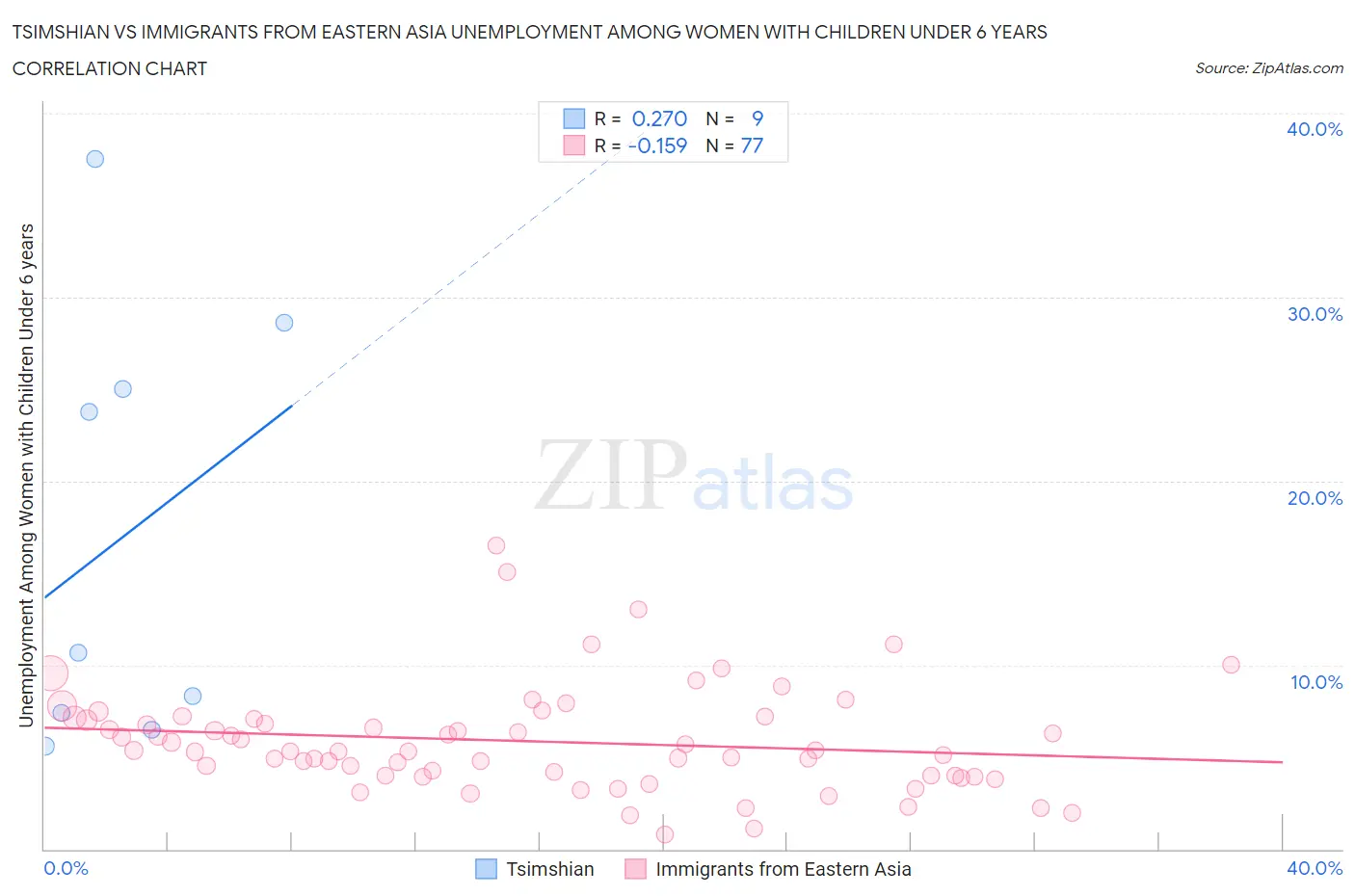Tsimshian vs Immigrants from Eastern Asia Unemployment Among Women with Children Under 6 years
COMPARE
Tsimshian
Immigrants from Eastern Asia
Unemployment Among Women with Children Under 6 years
Unemployment Among Women with Children Under 6 years Comparison
Tsimshian
Immigrants from Eastern Asia
6.6%
UNEMPLOYMENT AMONG WOMEN WITH CHILDREN UNDER 6 YEARS
100.0/ 100
METRIC RATING
32nd/ 347
METRIC RANK
6.3%
UNEMPLOYMENT AMONG WOMEN WITH CHILDREN UNDER 6 YEARS
100.0/ 100
METRIC RATING
13th/ 347
METRIC RANK
Tsimshian vs Immigrants from Eastern Asia Unemployment Among Women with Children Under 6 years Correlation Chart
The statistical analysis conducted on geographies consisting of 14,265,223 people shows a weak positive correlation between the proportion of Tsimshian and unemployment rate among women with children under the age of 6 in the United States with a correlation coefficient (R) of 0.270 and weighted average of 6.6%. Similarly, the statistical analysis conducted on geographies consisting of 354,997,962 people shows a poor negative correlation between the proportion of Immigrants from Eastern Asia and unemployment rate among women with children under the age of 6 in the United States with a correlation coefficient (R) of -0.159 and weighted average of 6.3%, a difference of 4.8%.

Unemployment Among Women with Children Under 6 years Correlation Summary
| Measurement | Tsimshian | Immigrants from Eastern Asia |
| Minimum | 5.6% | 0.80% |
| Maximum | 37.5% | 16.5% |
| Range | 31.9% | 15.7% |
| Mean | 17.0% | 5.9% |
| Median | 10.7% | 5.3% |
| Interquartile 25% (IQ1) | 6.9% | 4.0% |
| Interquartile 75% (IQ3) | 26.8% | 7.1% |
| Interquartile Range (IQR) | 19.9% | 3.1% |
| Standard Deviation (Sample) | 11.8% | 2.9% |
| Standard Deviation (Population) | 11.1% | 2.8% |
Demographics Similar to Tsimshian and Immigrants from Eastern Asia by Unemployment Among Women with Children Under 6 years
In terms of unemployment among women with children under 6 years, the demographic groups most similar to Tsimshian are Immigrants from Moldova (6.6%, a difference of 0.070%), Immigrants from Belarus (6.6%, a difference of 0.36%), Immigrants from Sweden (6.6%, a difference of 0.68%), Immigrants from Israel (6.5%, a difference of 0.94%), and Immigrants from Japan (6.5%, a difference of 0.96%). Similarly, the demographic groups most similar to Immigrants from Eastern Asia are Immigrants from Singapore (6.3%, a difference of 0.050%), Immigrants from Bulgaria (6.3%, a difference of 0.32%), Thai (6.3%, a difference of 0.42%), Immigrants from Uzbekistan (6.3%, a difference of 0.72%), and Immigrants from Malaysia (6.4%, a difference of 1.4%).
| Demographics | Rating | Rank | Unemployment Among Women with Children Under 6 years |
| Immigrants | Singapore | 100.0 /100 | #12 | Exceptional 6.3% |
| Immigrants | Eastern Asia | 100.0 /100 | #13 | Exceptional 6.3% |
| Immigrants | Bulgaria | 100.0 /100 | #14 | Exceptional 6.3% |
| Thais | 100.0 /100 | #15 | Exceptional 6.3% |
| Immigrants | Uzbekistan | 100.0 /100 | #16 | Exceptional 6.3% |
| Immigrants | Malaysia | 100.0 /100 | #17 | Exceptional 6.4% |
| Assyrians/Chaldeans/Syriacs | 100.0 /100 | #18 | Exceptional 6.5% |
| Mongolians | 100.0 /100 | #19 | Exceptional 6.5% |
| Ute | 100.0 /100 | #20 | Exceptional 6.5% |
| Burmese | 100.0 /100 | #21 | Exceptional 6.5% |
| Immigrants | Korea | 100.0 /100 | #22 | Exceptional 6.5% |
| Bulgarians | 100.0 /100 | #23 | Exceptional 6.5% |
| Laotians | 100.0 /100 | #24 | Exceptional 6.5% |
| Soviet Union | 100.0 /100 | #25 | Exceptional 6.5% |
| Cypriots | 100.0 /100 | #26 | Exceptional 6.5% |
| Immigrants | Japan | 100.0 /100 | #27 | Exceptional 6.5% |
| Immigrants | Israel | 100.0 /100 | #28 | Exceptional 6.5% |
| Immigrants | Sweden | 100.0 /100 | #29 | Exceptional 6.6% |
| Immigrants | Belarus | 100.0 /100 | #30 | Exceptional 6.6% |
| Immigrants | Moldova | 100.0 /100 | #31 | Exceptional 6.6% |
| Tsimshian | 100.0 /100 | #32 | Exceptional 6.6% |